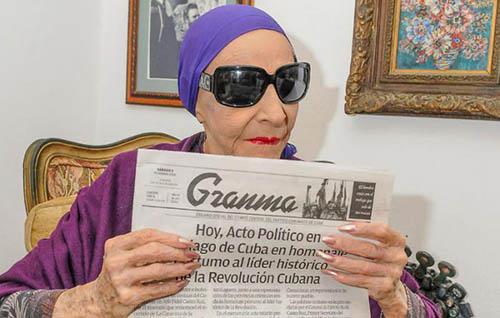
“I don’t want to talk about Fidel, because I cry,” Alicia tells me and I have to change the topic of our conversation for a moment.
“What’s you name?” she asks me.
“Amelia.”
“What?”
“Amelia, like Amelia Peláez, the painter.”
“No,” she replies, “Amelia like you.”
She squeezes my hands tight. Her hands are soft. Warm. It is Saturday, December 3, 7:23 p.m., and Cuba bids farewell to Fidel.
******
I ask her about the gala for January 1st that the National Ballet of Cuba holds each year.
“It’s the traditional gala dedicated to the triumph of the Revolution. It will be in the García Lorca Hall and we will put on an important classic again, The Nutcracker, which has not been performed for a long time. In addition, this 2017, the work celebrates 125 years since its world premiere,” she explains.
Alicia has been sad for several days and almost doesn’t want to talk. Her husband, Pedro Simón, follows the conversation and explains that afterwards the company will perform several tours in Cen

tral America and Europe; and that soon four couples of young Cuban ballet dancers will perform a mixed program in Baja California.
I want to insist and Pedro realizes. “Fidel has not left, we continue with the same spirit that he left us, of work and progress... we have many young dancers who are advancing by leaps and bounds and that’s the idea,” he continues in anticipation of my next question.
Days before, when the Comandante en Jefe’s death was announced, the Cuban National Ballet issued a statement on behalf of the prima ballerina assoluta: “The historic legacy that leaves us, immense and encompassing, is also widely represented in Cuban culture. That is why, always and forever, we say, “Thank you Fidel!”
Alicia herself, on previous occasions, had commented on Fidel’s close relationship with the Ballet.
“Fidel never doubted. He always saw in the ballet an elevated art, which the people deserved to know and enjoy, as well as its assimilation within our national culture. It seemed to him the most natural and logical thing in the world. He, as in everything, had a broader, far-reaching vision. His role in consolidating the art of ballet in Cuba is very important and not only for the material support, which he offered immediately, but for his understanding and enthusiasm for this artistic expression.”
But today Alicia does not want to talk. The grief eats her up.
We ask to take some photos. She agrees. We thank her.
The visit is short. She has spoken little. She squeezes my hands again. She has said it all.
Before I leave, I look around. I look at Alicia. She is sitting with a newspaper in her hands. On the wall hangs a picture of her with Fidel.















